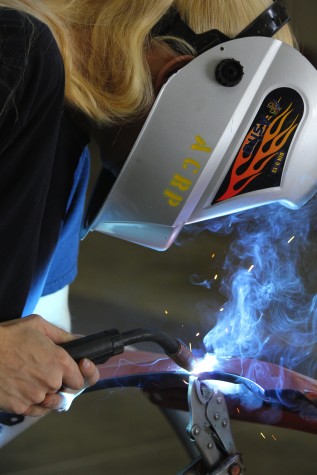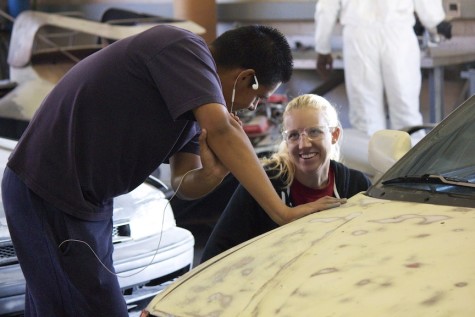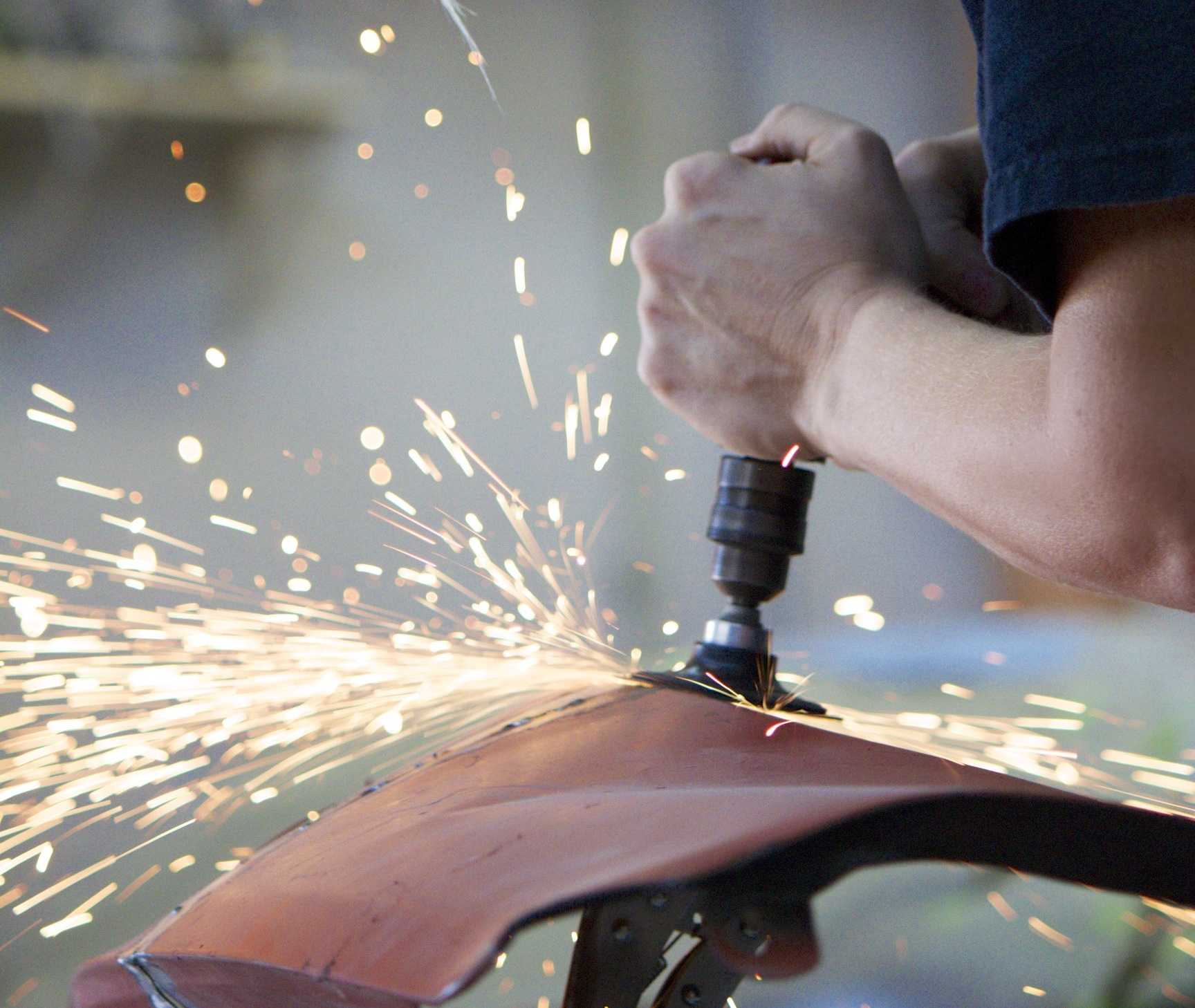Building cars and breaking stereotypes
April 24, 2015
Sparks fly overhead from her angle grinder as she works into the sheet metal, the sound echoing through the shop. She pauses to observe her work, silence sets in. She’s wearing a faded navy blue button down shirt with blue jeans and steel toe boots.
Her lips are bare, her eyes without shadow, her nails deprived of polish. Gently gliding the tips of her fingers across the sheet metal, she smiles and continues her work.
In an industry dominated by men, Patricia Fairchild, an automotive instructor, didn’t let social norms keep her from something she dreamt of doing as a young girl.
Fairchild’s talents led her to EC as an assistant professor in its automotive collision repair and painting program.
Looking back at her career in the automotive industry, she recalls a time after receiving her associate degree in automotive collision repair that illustrated how some people viewed women in the business.
While working at S&J Chevrolet car dealership painting cars, a male customer pointed out Fairchild’s gender and suggested that she was hired to paint the cars pink. She was so shocked, she didn’t know what to say, and to this day she has not painted a car that color.
“Not because of that stupid statement,” she said, “but who would want a pink car?”

Working with cars is her life passion, even though they were not prized at home.
Instead, cars were “just that thing in the driveway that gets you from here to there,” Fairchild said.
She didn’t start working on cars until her days as a student at Cerritos College. When she was a student at Mound Westonka High School in Minnesota, Fairchild was too scared and shy to take auto repair classes.
“There was no way I was going into that room with a bunch of rowdy young boys. No, no,” Fairchild said.
At her high school, she said, the auto program had a reputation as a program for students at the bottom of the GPA scale.
“It was a blue-collar type of class and my family didn’t really want me to go in that direction,” Fairchild said. “Art was OK, but auto body?”
After graduating from high school in 1992, Fairchild left home and traveled to California to attend school at Long Beach State where she received her B.A. She was accompanied by the first love of her life, a 1979 Chevrolet Blazer.
“This thing had rust holes so big, you could put your feet through them, like a Flintstone car,” she said.
Fairchild didn’t have money to have the work done on the car while attending college, so she learned how to do everything herself.
She worked on the upholstery, the wiring, rebuilt the engine, changed the carpet, did the bodywork, gave the car custom paint job and even made the headlight flip around.
“It was quite a truck,” she said. Fiairchild said she spent nearly 10 years working on her Blazer, up until it was stolen from outside her Lakewood apartment before it was finished.
“Don’t let the pretty trees fool you,” Fairchild said. “It was a bad neighborhood.”
While attending Long Beach State, one of her professors, who also taught at Cerritos College, suggested that she take a course at Cerritos in its automotive collision repair program. In 1997, she enrolled.
“All the instructors over at Cerritos were great,” Fairchild said. “They really helped me and didn’t mind starting at the absolute beginning. If I didn’t know a certain tool, they didn’t pair me up with a guy. They taught me what the tool was and how to use it.”
Now as an instructor, she applies that same type of atmosphere in her classroom to motivate her students.
She first joined EC in 2009, when the Dean of Industry and Technology Stephanie Rodriguez called Cerritos College and spoke with Bob Asperen, a automotive repair instructor, searching for someone to teach a auto repair class. Asperen referred Fairchild as one of his top pupils, which landed Fairchild a teaching position at EC.
Fairchild has observed the difference between male and female students who take her class. Her male students are typically young and are a “little shy” at first when they see a female instructor. Where as her female students are more likely to bond with her in the beginning, she said.
“There aren’t many girls in the automotive field and I was happy that a woman is teaching the class,” Claudia Callejas, 20, automotive collision repair major, said.
As the semester progresses, Fairchild builds a close bond with her students, male or female. She said she notices it’s easier for students to ask questions after gaining their trust and the male students start to “relax a bit.”
“They realize, ‘Oh, she really does know what she’s talking about. Who knew?’” Fairchild said.
Jesus Perez, 20, auto collision repair major wasn’t intimidated when he first learned a female would be teaching the class.
“I was actually looking forward to it,” Perez said, “she motivates you to do better.”
Fairchild has worked in auto repair shops and taught students in the classroom, but given the choice between teaching or working at a shop, “I’d rather be in my own garage, working on my own cars, and doing the restorations and customs that I do in my free time,” Fairchild said.
Teaching is a challenge for Fairchild, because if her students don’t know how to do something to their car, she has to teach them using words. She finds it tricky to use her student’s hands to fix their car.

However, helping students eventually becomes a rewarding experience for Fairchild when the work is complete and she sees the students’ excitement from her students when their cars turn out “gorgeous.”
“Working in shops is challenging. It’s a fast paced industry where time is money and the less time it takes to complete a job well, the more money you make,” Fairchild said.
Although she admires the work that shops do, Fairchild considers herself an artist and doesn’t like working under those conditions. She pays attention to detail and would rather take her time and “do it better than anyone else,” when it comes to working on cars.
“It earns me a great reputation, but no money,” she said. “I can’t eat a reputation.”
When encountering a person who doesn’t approve of women in a non-traditional industry, she encourages students to continue following their hearts and never give up.
“Life is too short, do your job, succeed, smile for the camera, and you don’t have to worry about competing all day long for a job you have every right to be in,” Fairchild said.

